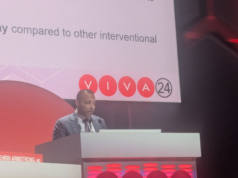
By Athanasios D Giannoukas
Today, venous stenting plays an important role in the treatment of deep venous pathologies. The current indications for its use include acute iliofemoral thrombosis after catheter-directed or pharmacomechanical thrombolysis to resolve residual iliac stenosis, May-Thurner syndrome and the reopening of chronically occluded veins in patients with post-thrombotic syndrome. In such cases, 2–4 stents may be required while the stent should extend into the inferior vena cava or may also extend below the inguinal ligament inside the common femoral vein to allow free outflow from the deep femoral vein.
All venous stents used in venous pathologies are self-expandable stents. The first stent used in the early period was the Wallstent from Boston Scientific, which was not specifically designed for the venous system. The device provides good radial force because of its close-cell design at the expense of less flexibility. The available diameters and lengths are in the range of 10–16mm and 2–9cm, respectively. Zilver Vena from Cook Medical is a new-comer in the field and has been specifically designed for the venous system with open-cell design providing more flexibility and kink resistance and is available in 14mm and 16mm diameters and in 6cm, 10cm and 14cm lengths. The Vici stent from Veniti is another venous stent with close-cell design with high crash resistance while maintaining good flexibility. This design was elected by the engineers of the company in order to provide greater coverage and support to vessel walls that have little smooth muscle of the tunica media. Optimed has recently launched a series of stents designed specifically for different venous territories: sinus-XL, available from 16mm to 36mm in diameter and from 3cm to 10cm in length and that can be used in the inferior and superior vena cava; sinus-Venous, with independent ring system and flash links providing power and flexibility for the iliac and femoral veins; and the most interesting new comer from the same company, sinus-Obliquus, with a beveled top end to be placed exactly at the confluence of the common iliac veins without protruding into the inferior vena cava.
Indeed, all the aforementioned evolution in venous stent technology over the last years has improved the performance of venous stenting opening up new horizons in the treatment. However, we are still some way from having available the ideal venous stent. The characteristics of such stent could be summarised as following:
- Deployment without foreshortening
- Tapered
- Good visibility and flexibility
- Resistant against compression and high hoop strength
- Resistant to thrombus formation and platelet adherence
- MR compatible
- Diameters 10–22mm and length 4–10cm
- Tolerate radius curvature of 2cm without protrusion of the metallic components of the cell structure inside the lumen
- Reach and retain the target diameter by balloon angioplasty
- Beveled to be placed in the confluences/fenestrated
- Be inexpensive.
An important feature that should be pointed out from various relevant studies is that in several reports there is a difference in the outcome of venous stenting between thrombotic and non-thrombotic pathologies. P Neglen and S Raju in their series reported 89% primary patency in non-thrombotic cases and 65% in the thrombotic cases in a three-year follow-up (JVS 2002;35:694–700). Therefore, it appears reasonable to think that the “one size fits all” approach may not be applicable in venous stenting. Stents with specific design may be needed to treat the entire spectrum of venous pathologies. Is this possible? From the evolution in stent technology which we have all witnessed in the arterial pathologies, for instance in the carotid territory with the introduction of stents with micromeshes and heparin bonding or in the femoropopliteal region with the drug-eluting stents and the vascular mimetic technology, it is realistic to expect similar advances in venous stents.
The prospect of an hybrid stent with a more rigid top end—to provide good radial force at the confluence of left common iliac to resolve the compression of the right iliac artery—and a more flexible distal part—to accommodate the needs of external iliac veins—is not unrealistic. Additionally, stents of open-cell design to provide flexibility, with micromesh and heparin bonding or drug-eluting technology, could overcome the shortcomings of current stents used in acute thrombotic cases or chronically occluded veins, respectively.
As technology moves fast and venous stenting gains popularity in the management of iliofemoral vein pathologies, advancements that may look like fantasy today may become, sooner or later, a reality in clinical practice.
Athanasios D Giannoukas is a professor of Vascular Surgery, Faculty of Medicine, University of Thessaly, Greece, chairman, Department of Vascular Surgery, University Hospital of Larissa, Greece, and secretary general of the European Venous Forum












